BigPanda
Flow Designer has a BigPanda Incidents trigger and built-in BigPanda steps to help you integrate BigPanda into your alert management and incident response flows.
BigPanda Steps
The following steps are available:
- Add Comment: automatically add a comment to an existing BigPanda Incident.
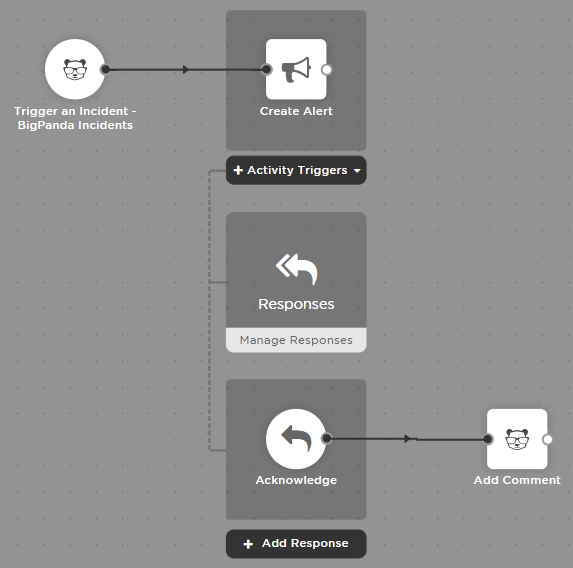
In the example above, the flow creates an alert when a signal from BigPanda comes into xMatters. When a user acknowledges the notification, a comment is added to the BigPanda Incident.
To add a BigPanda step to your flow:
- Go to the Apps tab of the palette, expand the BigPanda section, and drag the Add Comment step onto the canvas.
- For instructions on using the BigPanda trigger, see BigPanda Incidents trigger.
- Connect the step to the previous step in the flow. This gives you access to the alert properties and outputs of previous steps when you configure this step's inputs.
- Double-click the step to edit it, and use the Setup tab to configure the inputs. You can use plain text and input variables (or both). See the following section for detailed information on the inputs, including which are required.
- On the Endpoint tab, configure the step to point to your BigPanda instance.
- You can select a pre-existing endpoint or configure a new endpoint
Add Comment
Use the Add Comment step to automatically add a comment to an existing BigPanda Incident. Map outputs from previous steps to the inputs to create the comment and determine what incident to comment on.
Inputs
Inputs with an asterisk* are required.
|
Label |
Description |
|---|---|
|
API Key* |
BigPanda API Key to authenticate the request. |
| Incident ID* | Unique ID of the incident in BigPanda. |
| Comment* | Comment to add to the existing BigPanda incident. |
Outputs
This step has no outputs.
BigPanda Incidents trigger
The built-in BigPanda Incidents trigger initiates a flow when it receives a request from a webhook in BigPanda.
Add the BigPanda Incidents trigger to the canvas
- Go to the Triggers tab in the palette, expand the App Triggers section and drag the trigger onto the canvas.
- Double-click the trigger (or click the pencil icon).
- Set the authenticating user, and then copy URL — you'll use this to set up the webhook in BigPanda. Alternatively, you can create an integration user to use as the authenticating user.

- Click the Flood Control tab to edit the trigger's default flood control settings. For more information about these settings, see Trigger Flood Control.
- Click Done.
- On the flow canvas, connect the steps you want to run when xMatters receives a request to that URL.
You're now ready to configure BigPanda to target the trigger.
Configure BigPanda to send requests to the trigger URL
To have BigPanda send alerts to the flow trigger, you need to configure a webhook and set it to use the trigger URL.
Create an integration between BigPanda and xMatters.
- In BigPanda, navigate to the Integrations tab and click New Integration.
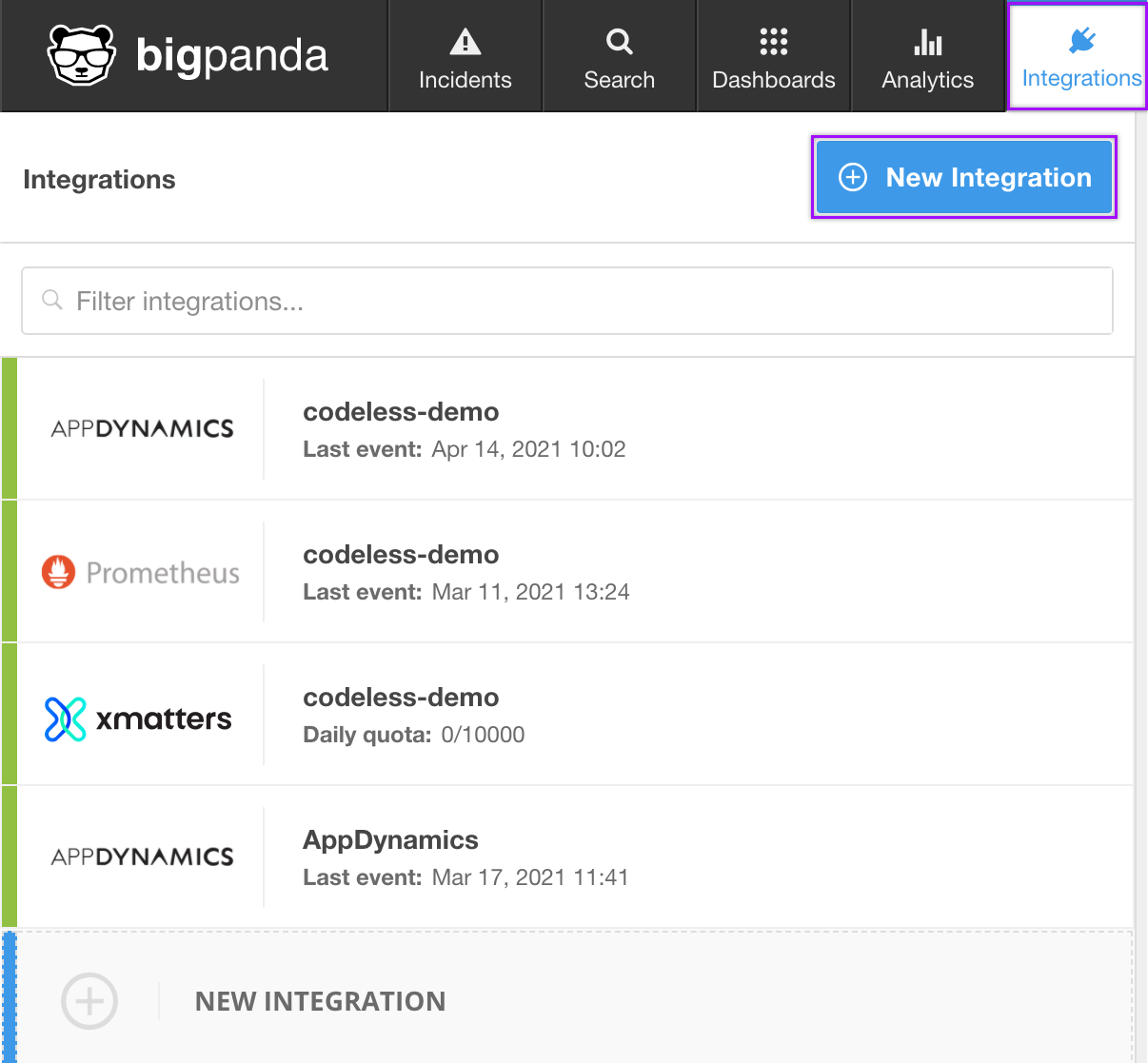
- Locate xMatters in the list of available integrations and click Integrate.
- Create an App Key. Give the integration a name, then click Generate App Key.
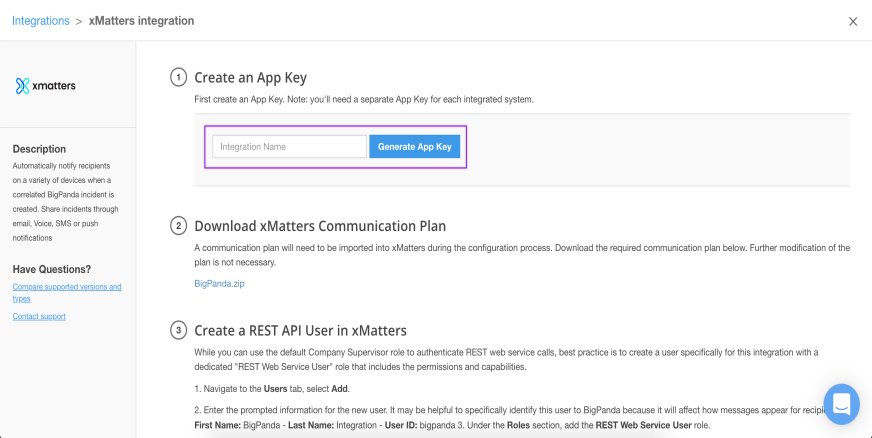
- Skip sections 2 - 7 on the BigPanda integration page as they are no longer required.
- In the Configure BigPanda section, paste the trigger URL from Flow Designer into the Callback URL field.
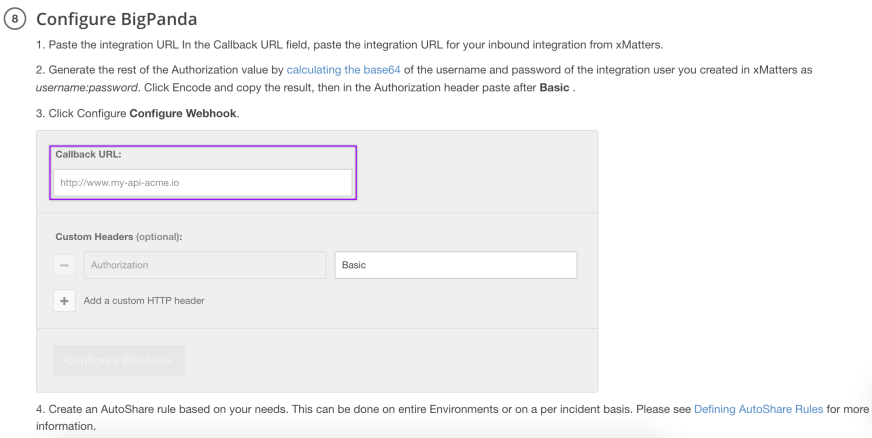
- If you use URL Authentication, continue on to the next step.
- If you use Basic Authentication, use the link on the BigPanda page to generate a Base64 encoded authorization for the authenticating user. Paste the generated value after the word Basic in the Custom Headers section.
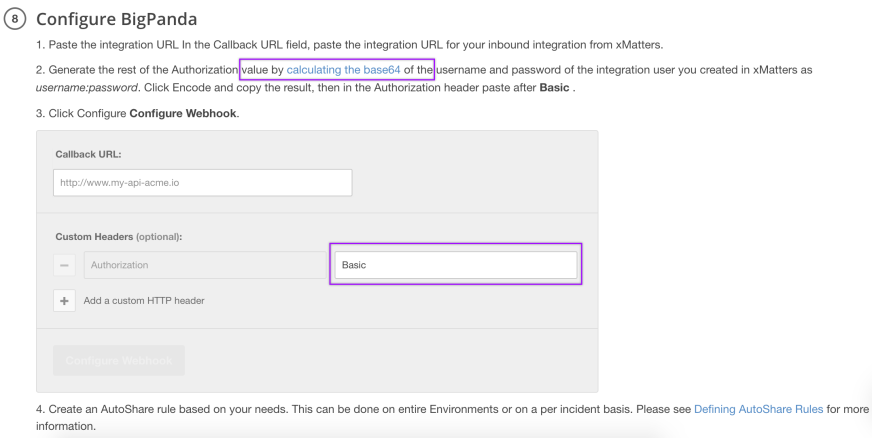
- Add the target names of any recipients you want to notify when the alert fires.
- For URL authentication, use an ampersand to attach recipients. For example, if you want to notify Emma Pearson and the on-call members in the group responsible for the Antares service, you'd add &recipients=epearson,antares to the end of the URL.
- For other authentication types, use a question mark to attach recipients. For example, if you want to notify Barry Gull and the on-call members in the group responsible for the Cassiopeia service, you'd add ?recipients=bgull,cassiopeia to the end of the URL.
- You must URL-encode any special characters or spaces in the target names.
- Click Configure Webhook to save the integration.
Now that the integration is created, use BigPanda's Autoshare capabilites to share data from BigPanda.
- On the top right-hand side of the page, expand the Settings menu (represented by a gear icon) and click AutoShare.
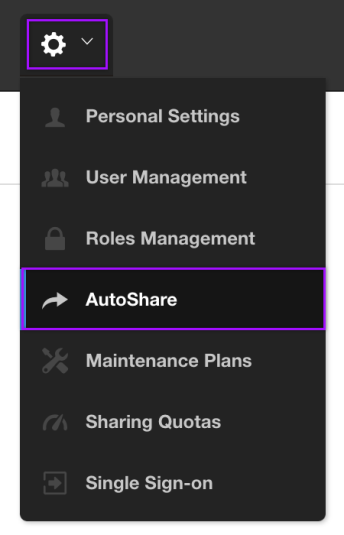
- Click Create AutoShare.
- In the Create AutoShare window, set the following fields:
- Choose Environment: Expand the drop-down menu and select All.
- Escalate via: Expand the drop-down menu and select the xMatters integration you just created.
- Click Next.
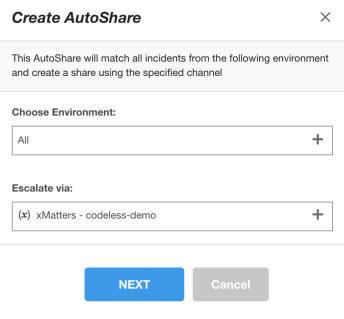
- Optional: Add a message the AutoShare. The message is displayed in the Recent Activity section whenever BigPanda sends a signal to xMatters.
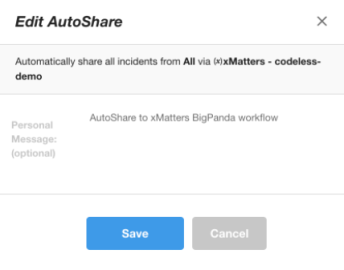
- Click Save.
You're ready to use the webhook to trigger automated flows, including steps such as sending alerts and initiating incidents, though we always recommend testing before putting things into use.
Outputs
The BigPanda Incidents trigger has the following outputs you can use as inputs to steps further along the flow.
|
Label |
Description |
|---|---|
| Recipients | List of targeted recipients. Recipients are set by adding a recipients query parameter to the trigger URL when you configure the webhook in BigPanda. |
| Signal Mode | Determines the flow path to follow, based on the value of the Status parameter. |
| Signal ID | Key or identifier used to terminate or correlate events/signals |
| Active |
Activity level of the BigPanda incident. Available options are:
|
| Description | Description of the first alert. |
| Incident ID | Unique ID of the BigPanda incident. |
| Link | Direct URL to the incident in BigPanda. |
| Primary Property Name | Primary property name from the first alert. |
| Primary Property Value | Primary property value from the first alert. |
| Secondary Property Name | Secondary property name from the first alert. |
| Secondary Property Value | Secondary property value from the first alert. |
| Source System | Source system that initiated the incident in BigPanda. |
| Started On | Time the incident started in BigPanda in UNIX format. |
| Status |
Status of the incident in BigPanda. Available options are:
|
| Raw Request | JSON representation of the request that can be parsed separately to get additional context on outputs. |